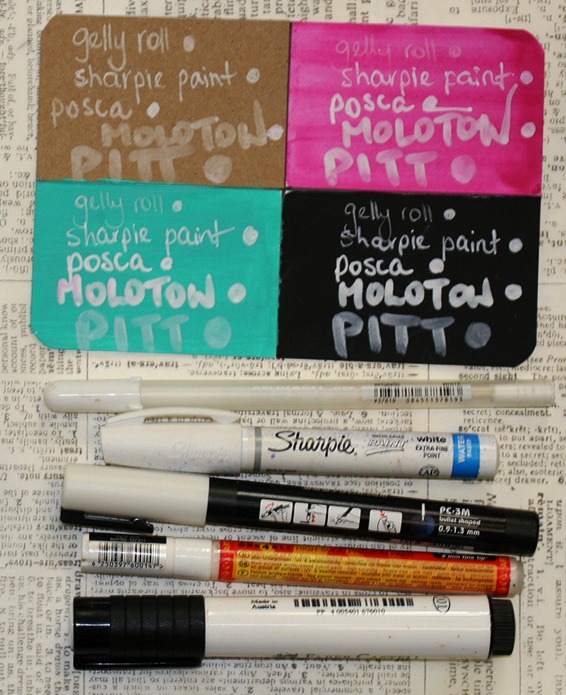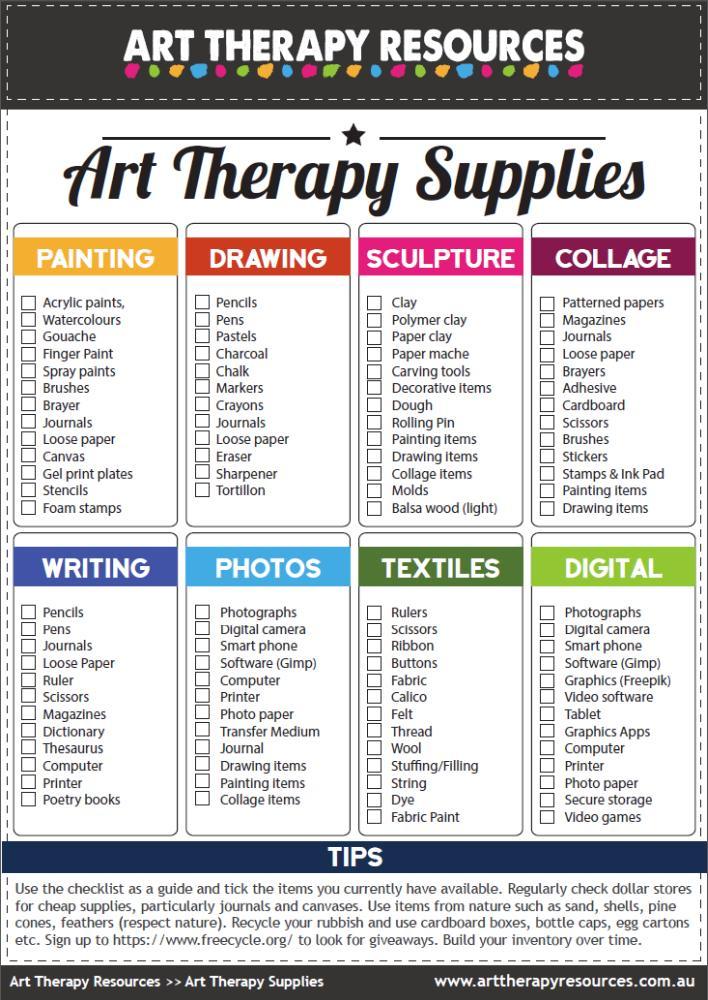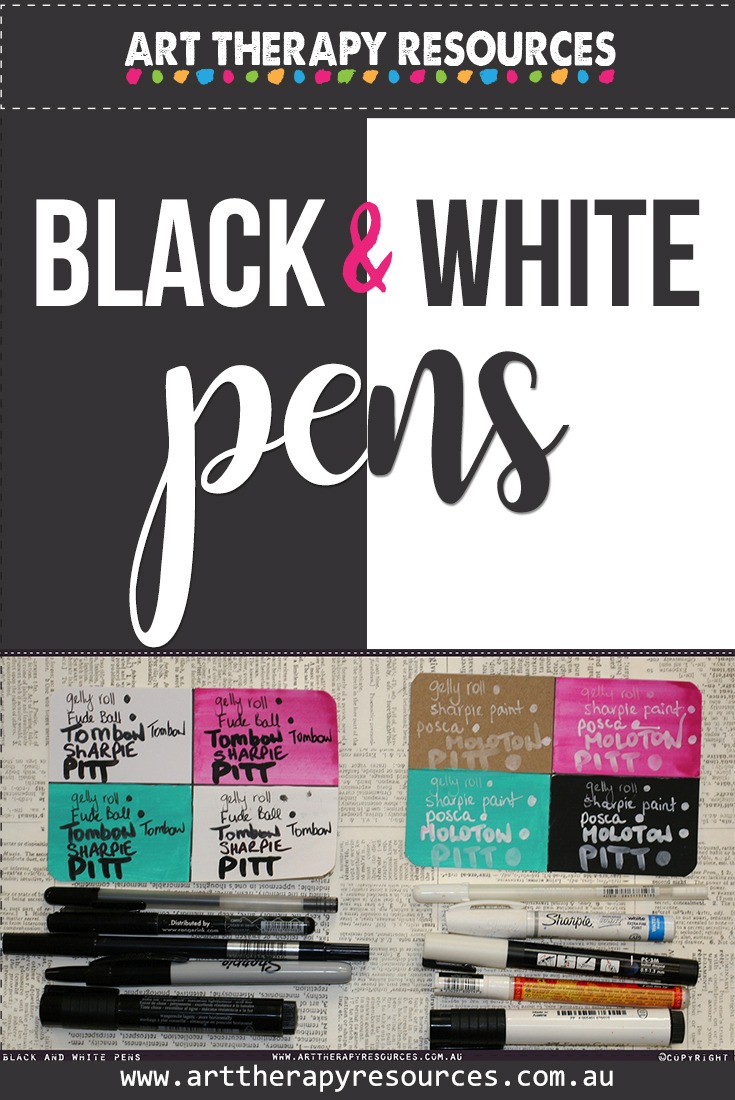THIS POST INCLUDES:
1. Pens as Basic Art Supplies
2. Types of Pens
3. 5 Suggested Black Pens
4. 5 Suggested White Pens
5. Free Download Art Therapy Supplies List
PENS AS ART THERAPY SUPPLIES
Pens are a staple item in an art therapy supplies list. Most clients will be familiar with pens which may help address any hesitation in using unfamiliar art supplies. In this post, we’re going to look at the various types of pens you may consider adding to your art therapy supplies. We’re also going to include a test of 5 black and 5 white pens. The test will include using the pens on:
- Plain paper/cardstock
- On top of watercolour paints
- On top of acrylic paints
- On top of gesso
Using them on a number of different surfaces will give an indication of how robust and flexible the pens are in different types of art.
TYPES OF PENS
There is a long list of the types of pens available to use in art therapy. Below is a list of some of the most common types along with a comment on the benefits and drawbacks of each pen:
- Ballpoint – inexpensive and familiar to use but can be limiting in creating artworks with full colour coverage
- Fiber tip – gives an ink load that is more intense, however the nib can easily collect other art materials if they are not completely dry
- Fountain – creates a nice flow of ink but requires a little skill to use and maintain them
- Gel ink – intense pigment and a variety of colours available, however the pens seem to have a shorter life span than other pens
- Markers (felt tip) – allows for broader coverage of colour, however there is a risk of the marker drying out faster. Can also get clogged if used over other art materials that are not completely dry.
- Oil based – useful for writing on various surfaces including paper, metal, stone, glass, however the paint can sometimes become blocked and stop flowing from the nib
- Paint Pens – useful for writing on various surfaces including paper, metal, stone, glass, however the paint can sometimes become blocked and stop flowing from the nib
- Roller ball – inexpensive and familiar to use, however sometimes the ball can stop rolling and prevent an easy flow of ink
5 SUGGESTED BLACK PENS
The pens we are testing in this post include the following. We’ve included an Amazon (affiliate) link if you wish to purchase these pens. The pens were tested in 4 different ways: cardstock, on watercolours, on acrylic paint, and on gesso.
- Black Fude Ball Pen http://amzn.to/2k9pjhB
- Faber Castell Big Brush Pen Black http://amzn.to/2lLN7fp
- Gelly Roll Medium Black Pen http://amzn.to/2hrcnGk
- Tombow Dual Brush Pen http://amzn.to/2nnSuCd
- Sharpie Retractable Fine Point Markers http://amzn.to/2n6Oerh

VERDICT:
All of the pens had no problem writing on top of each of the surfaces (cardstock, watercolour, acrylic paint, gesso). The gelly roll is probably the most versatile as you can use it for smaller line work as well as thickening up lines. The fude ball pen is inkier than the gelly roll, however, sometimes the nib is a little too thick for some thin line drawing. The fude ball pen writes over rough surfaces better than the gelly roll pen, however, it does have a longer drying time than the gelly roll pen.
The pitt pen is great for large sections of colouring or writing large words. Faber Castell states the pens are waterproof, however it takes some time for them to dry as they are highly pigmented. If you’re using them in artwork, be careful with water around them until the ink is completely dry.
The tombow pen has a nice brush type nib for calligraphy, however, I think the Pitt Brush Pen is a much nicer pen to work with and has a nicer ink flow.
*My recommended purchases would be the Gelly Roll and Pitt Big Brush. They are the most consistent for ink flow, coverage and overall use across all surfaces.
5 SUGGESTED WHITE PENS
The pens we are testing in this post include the following. We’ve included an Amazon (affiliate) link if you wish to purchase these pens. The pens were tested in 4 different ways: cardstock, on watercolours, on acrylic paint and on gesso.
- Sharpie Paint Pen X-Fine http://amzn.to/2hCZcSZ also available in Medium http://amzn.to/2j36ChW
- Gelly Roll Medium Pen http://amzn.to/2jIhD9G
- Faber Castell Big Brush Pen White http://amzn.to/2prNYQX
- Molotow ONE4ALL Acrylic Paint Marker 1.5mm Signal White http://amzn.to/2prNj1X
- Uni Posca Extra Fine Marker White http://amzn.to/2oW4H2R

VERDICT:
Most of the pens worked on the various surfaces (cardstock, watercolour, acrylic paint, gesso). The Molotow and Pitt Big Brush pens were the two pens that didn’t work as well across all surfaces. The Pitt Big Brush pen didn’t work very well on any surfaces unfortunately which is surprisingly given how good the black pen of the same brand works.
The sharpie paint pen is a great pen that works well across all surfaces and comes in a range of sizes. However, it can sometimes be unreliable in terms of keeping the paint/ink from flowing. The Uni Posca pen was the easiest pen to use across all surfaces. The gelly roll is great for fine line work and works well across all surfaces. The watercolour surface is where the pen struggled to flow.
*My recommended purchases would be the Gelly Roll and Uni Posca. They are the most consistent for ink flow, coverage and overall use across all surfaces.
FREE ART THERAPY SUPPLIES LIST
SIGN UP below to download the FREE Art Therapy Supplies List

BUILD YOUR ART THERAPY REFERENCE MATERIALS:
Pin this image to your Pinterest board.

SHARE KNOWLEDGE & PASS IT ON:
If you’ve enjoyed this post, please share it on Facebook, Twitter, Pinterest. Thank you!
